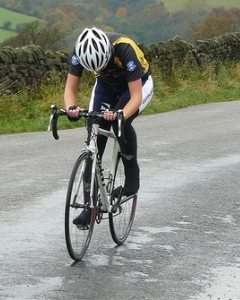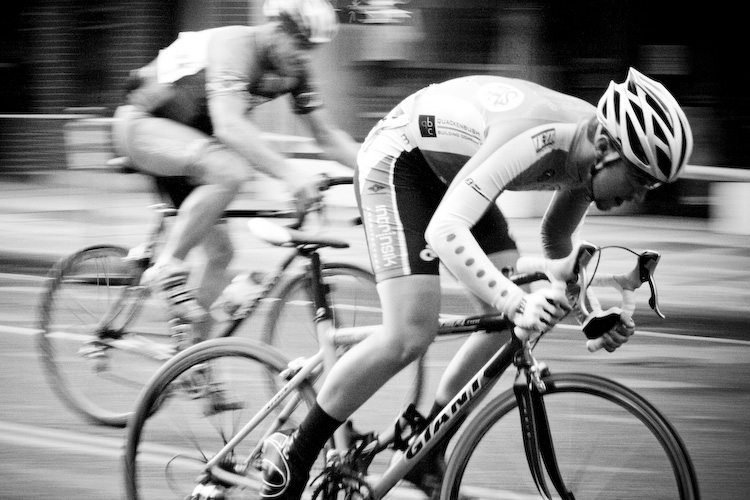Among the many weapons in the armament of the cyclist who wants to ride stronger, one of the least practiced and most important is VO2 max repeatability. The ability to accelerate and push your body to the limits, recover at threshold and repeat that process over and over is one of the most versatile and important skills for a cyclist to possess. It's also the one that's almost always lacking in the cyclists that I consult with or coach, and it's one I drill home in my training plans.
The real question most people follow up with is “why?”
Before I answer, first let's delve into VO2 max a little bit. For our purposes, a VO2 max level effort (or a Zone 5/Z5 effort) is a suprathreshold effort that is sustainable for around 3-8 minutes (depending on the intensity of the effort.) It is a mixture of aerobic and anaerobic energy production and is most often used in pursuits, attacks, bridging small gaps and short climbs. By the numbers, it's an 8 to an 8.5/10 on an RPE scale, 105%-120% of Functional Threshold Power and >105% Lactate Threshold Heart Rate.
After the jump, I'll give you some more detailed information and a couple workouts to help you build your Zone 5 Repeatability (Z5R).
 Why VO2 Max Repeatability?
Why VO2 Max Repeatability?
Technically, VO2 max repeatability works to build physiological adaptation and skill that allows riders to repeatedly up the pace for a period of time, then back down to their threshold and hammer out a solid time trial level pace. By repeatedly challenging the VO2 max level energy system, we force the body to learn how to recover from these “red zone” efforts. The less time between intervals we give the body to recover, and the harder we work during that recovery interval dictates how efficiently our body can “recover” from these repeated efforts. By varying the length and intensity of our recovery, we can adapt to differing situations on the road and build our repeatability skills without allowing the body to become “complacent.”
Physiologically, we're using these kinds of efforts to deplete our W' component and force our body to both recharge it faster and to raise our maximal oxygen uptake capacity to handle those high intensity efforts. Depleting our W' is kind of like burning up all the nitrous in a boosted car: it's the “go juice” that lets your body work super hard for short periods of time. Multiple, repeated efforts at a Zone 5 level will deplete those reserves and force the body to adapt by increasing the amount of anaerobic energy substrate availble (increasing the amount of W' your body has, or increasing the size of the nitrous tank in the car) and raising your maximal oxygen uptake and the aerobically derived energy that it can produce.
For example, you've probably watched professional races where climbers attack repeatedly trying to “snap the elastic.” Those who are able to will jump on the wheel or claw their way back to the attacker's wheel, only to have the attacker jump away again. Eventually someone has to crack, and someone will ride away. This exemplifies the importance of Zone 5 repeatability: would you rather be the guy who can repeatedly jump away from the group (or latch on to the guy who is) or the guy who blows up and starts going backwards?
The key to Zone 5 repeatability is to consistently push your body into that VO2 max level effort and practice recovering at threshold. Why don't most cyclists possess this skill already, since many of them are constantly working in groups (which simulates this very nicely)? Well, most cyclists don't push themselves into Zone 5 regularly in their solo training because it hurts. It hurts bad. It's hard work.
On the occasions they do jump into zone 5, they almost never recover at threshold, because it's actually very hard to recover there. They will drop their effort, cadence or power into zone 2 or 3 levels (especially on the trainer.) On the road, we all too easily coast down the descent on the other side of a climb without applying ANY power to the pedals, which puts us in zone 2 at best. If you want to up the ante and build fitness faster, pushing yourself during the recovery interval is one of the biggest keys to increasing your Z5 fitness. That's what will help you stay with group ride surges and race moves.
 Specific practice is required to master such a skill, so once or twice a week try these VO2 max workouts to build your Zone 5 repeatability and fitness:
Specific practice is required to master such a skill, so once or twice a week try these VO2 max workouts to build your Zone 5 repeatability and fitness:
Tabata Type Intervals:
In a big gear, sprint (in the saddle or out, or mix it up) for 30 seconds all out then recover for 30 seconds with easy spinning. Repeat. Start with 3 sets of 3 repeats each (3 minutes rest between sets) and work up to 5 sets.
By pushing as hard as you can and recovering easily, you end with an average power or HR in the zone 5 area. This is an old high intensity training trick. If you can't handle 30/30s yet, consider 15 seconds of all out effort and 45 seconds of recovery. Once you're up to 5 sets, raise the intensity of your recovery period to your sweet spot power (91% FTP) and once that's doable, raise it to 100% FTP.
Once you've conquered all those variations, do 45 seconds on and 15 seconds off.
That'll keep you busy for a few months worth of workouts.
Zone 5/VO2 Max Repeats:
To simulate the changes in pace of a group ride, you'll start cranking out longer intervals for these repeats. Get yourself up to threshold gearing and pace. Then start your stopwatch. You're going to ride 1 minute at threshold (zone 4/100% FTP) and then accelerate for 30 seconds at VO2 max (zone 5/105%-120% FTP). Start with 5 repeats (no rest in between) and work up to 10. To vary the theme, lengthen the VO2 max portion of the interval while either maintaining or decreasing the “rest” period. You can accelerate up to zone 5 by either increasing your cadence, shifting to a harder gear or doing both.
A great variation on these is performing them on climbs. You can do the threshold portion seated on the climb and accelerate it if the saddle for the VO2 max portion of the interval.
These intervals are perfectly designed to simulate the changes in a group ride or race peloton's pacing and it forces your body to learn how to recover while still under pressure.
Zone 5 Beatdown
AKA the “Hacksaw” Jim Duggan workout. 2x4s. 2×4 minutes flat out. All. Day. Long.
If your goal is to burn up all the anaerobic energy you have so you can really train your VO2 max hardcore, these are the intervals for you. You'll warm up well before you get into the first set of these, which will be as follows:
Get yourself settled into a gear and cadence that puts you around 120% of your FTP (about an 8.75/10 RPE) and stay there for 4 minutes. Then you'll recover for 2 minutes of easy spinning before ramping back up again. One set of intervals will be 10 minutes (including the rest interval between). After you do the first 2×4, take 4 minutes to compose yourself and do it again.
And again.
And if you're able to pick yourself off the pavement, DO IT AGAIN!
What you'll find is that you'll have a harder and harder time holding that 120% FTP mark, especially during the later efforts. In this case, you should continue the interval even if you have to drop the power to be able to finish the effort. If you find that you can't hold that effort about 105% of FTP and you're dipping below that, finish out that interval at threshold and then pack it in for the day.
Things To Keep In Mind
So there you have it. Before you know it, you'll not only be hanging onto the group, you'll be attacking it from the front, making others ask “what have you been doing to get this strong?”
Has a nice ring to it, doesn't it?
If you enjoyed this article, don't forget to sign up for my newsletter to get more training tips and coaching advice, and check out my downloadable training plans for more high-powered training solutions.
